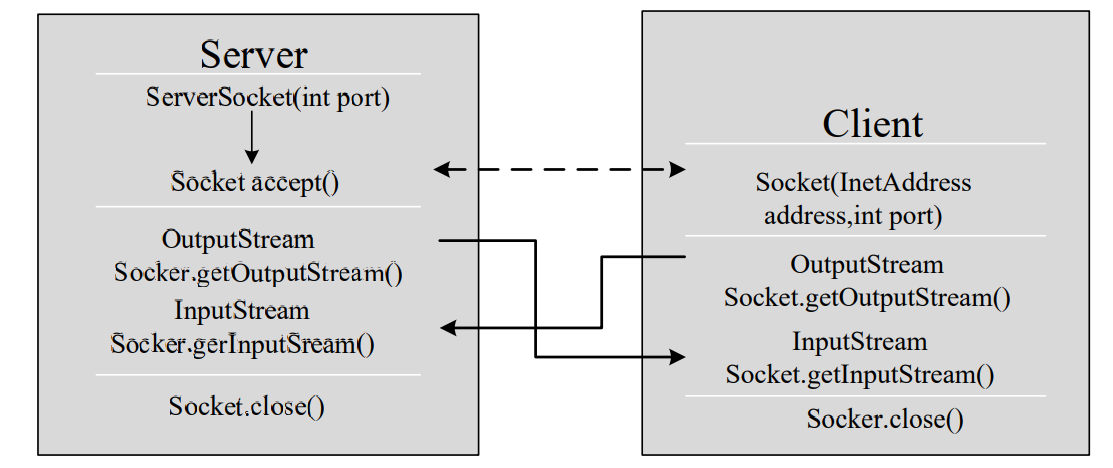基于Socket的TCP编程
Java语言的基于套接字编程分为服务端编程和客户端编程,其通信模型如图所示:
客户端Socket的工作过程的四个基本的步骤
创建 Socket:
根据指定服务端的 IP 地址或端口号构造 Socket 类对象。若服务器端响应,则建立客户端到服务器的通信线路。若连接失败,会出现异常。
打开连接到 Socket 的输入/出流:
使用 getInputStream()方法获得输入流,使用 getOutputStream()方法获得输出流,进行数据传输
按照一定的协议对 Socket 进行读/写操作:
通过输入流读取服务器放入线路的信息 (但不能读取自己放入线路的信息),通过输出流将信息写入线程。
关闭 Socket:
断开客户端到服务器的连接,释放线路
注意事项
- 客户端程序可以使用Socket类创建对象,创建的同时会自动向服务器方发起连接。Socket的构造器是:
Socket(String host,int port)throws UnknownHostException,IOException
向服务器(域名是 host。端口号为port)发起TCP连接,若成功,则创建Socket对象,否则抛出异常。Socket(InetAddress address,int port)throws IOException
根据InetAddress对象所表示的 IP地址以及端口号port发起连接。
public void client() {Socket socket = null;OutputStream os = null;try {//1.创建Socket对象,指明服务器端的ip和端口号InetAddress inet = InetAddress.getByName("192.168.14.100");socket = new Socket(inet,8899);//2.获取一个输出流,用于输出数据os = socket.getOutputStream();//3.写出数据的操作os.write("你好,我是客户端mm".getBytes());} catch (IOException e) {e.printStackTrace();} finally {//4.资源的关闭if(os != null){try {os.close();} catch (IOException e) {e.printStackTrace();}}if(socket != null){try {socket.close();} catch (IOException e) {e.printStackTrace();}}}}
服务器程序工作过程的四个基本的步骤
调用 ServerSocket(int port) :
创建一个服务器端套接字,并绑定到指定端口 上。用于监听客户端的请求。
调用 accept():
监听连接请求,如果客户端请求连接,则接受连接,返回通信套接字对象。
调用该Socket类对象的 getOutputStream() 和 getInputStream ():
获取输出流和输入流,开始网络数据的发送和接收。
关闭ServerSocket和Socket对象:
客户端访问结束,关闭通信套接字。
使用说明
- ServerSocket 对象负责等待客户端请求建立套接字连接。也就是说,服务器必须事先建立一个等待客户请求建立套接字连接的ServerSocket对象。
所谓“接收”客户的套接字请求,就是accept()方法会返回一个 Socket 对象
public void server() {ServerSocket ss = null;Socket socket = null;InputStream is = null;ByteArrayOutputStream baos = null;try {//1.创建服务器端的ServerSocket,指明自己的端口号ss = new ServerSocket(8899);//2.调用accept()表示接收来自于客户端的socketsocket = ss.accept();//3.获取输入流is = socket.getInputStream();//不建议这样写,可能会有乱码// byte[] buffer = new byte[1024];// int len;// while((len = is.read(buffer)) != -1){// String str = new String(buffer,0,len);// System.out.print(str);// }//4.读取输入流中的数据baos = new ByteArrayOutputStream();//ByteArrayOutputStream 是字节数组输出流。它继承于OutputStream。//ByteArrayOutputStream 中的数据被写入一个 byte 数组。缓冲区会随着数据的不断写入而自动增长。//可使用 toByteArray() 和 toString() 获取数据。byte[] buffer = new byte[5];int len;while((len = is.read(buffer)) != -1){//将数据读入到buffer数组baos.write(buffer,0,len);//将buffer数组写出到baos}System.out.println(baos.toString());System.out.println("收到了来自于:" + socket.getInetAddress().getHostAddress() + "的数据");//获取此 IP 地址的主机名} catch (IOException e) {e.printStackTrace();} finally {if(baos != null){//5.关闭资源try {baos.close();} catch (IOException e) {e.printStackTrace();}}if(is != null){try {is.close();} catch (IOException e) {e.printStackTrace();}}if(socket != null){try {socket.close();} catch (IOException e) {e.printStackTrace();}}if(ss != null){try {ss.close();} catch (IOException e) {e.printStackTrace();}}}
/*** 实现TCP的网络编程* 例题3:从客户端发送文件给服务端,服务端保存到本地。并返回“发送成功”给客户端。* 并关闭相应的连接。* @author shkstart* @create 2019 下午 4:13*/public class TCPTest{/*这里涉及到的异常,应该使用try-catch-finally处理*/@Testpublic void client() throws IOException {//1.Socket socket = new Socket(InetAddress.getByName("127.0.0.1"),9090);//2.OutputStream os = socket.getOutputStream();//3.FileInputStream fis = new FileInputStream(new File("beauty.jpg"));//4.byte[] buffer = new byte[1024];int len;while((len = fis.read(buffer)) != -1){os.write(buffer,0,len);}//关闭数据的输出socket.shutdownOutput();//5.接收来自于服务器端的数据,并显示到控制台上InputStream is = socket.getInputStream();ByteArrayOutputStream baos = new ByteArrayOutputStream();byte[] bufferr = new byte[20];int len1;while((len1 = is.read(buffer)) != -1){baos.write(buffer,0,len1);}System.out.println(baos.toString());//6.fis.close();os.close();socket.close();baos.close();}/*这里涉及到的异常,应该使用try-catch-finally处理*/@Testpublic void server() throws IOException {//1.ServerSocket ss = new ServerSocket(9090);//2.Socket socket = ss.accept();//3.InputStream is = socket.getInputStream();//4.FileOutputStream fos = new FileOutputStream(new File("beauty2.jpg"));//5.byte[] buffer = new byte[1024];int len;while((len = is.read(buffer)) != -1){fos.write(buffer,0,len);}System.out.println("图片传输完成");//6.服务器端给予客户端反馈OutputStream os = socket.getOutputStream();os.write("你好,美女,照片我已收到,非常漂亮!".getBytes());//7.fos.close();is.close();socket.close();ss.close();os.close();}}


